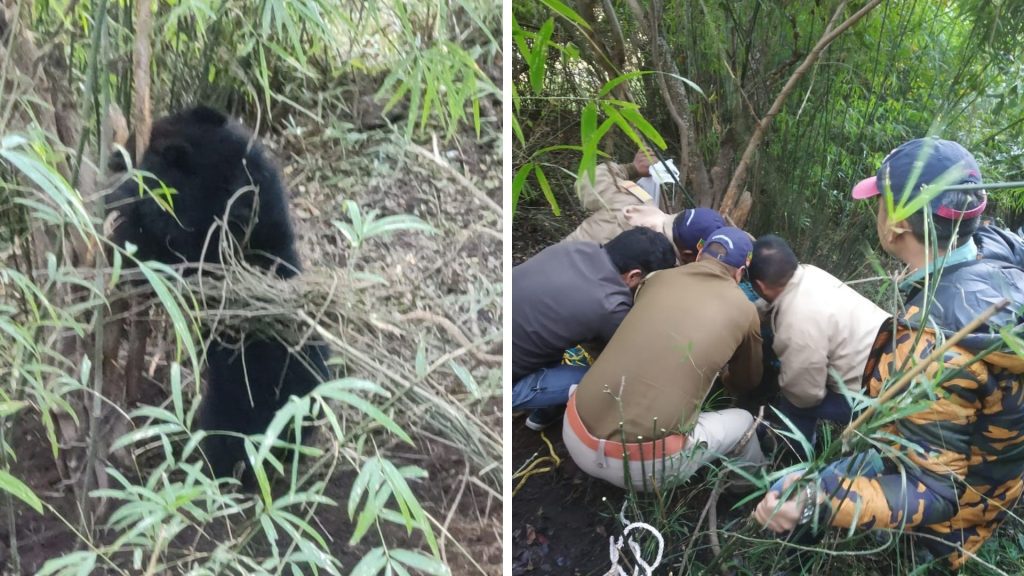The rescue operation of a young Black Himalayan Bear in Uttarakhand, led by Indian Forest Service officer Vaibhav Singh, is grabbing eyeballs in social media these days and winning hearts as well. The sub-adult bear got caught in a snare wire trap in the forest area of a remote village named Parkandi in the Augustmuni range of Rudraprayag division. The forest is around two kilometers away from the main road.
As the animal was young, it did not try to escape, or else it could have led to serious injuries or even death. Thankfully, word went out and reached IFS Vaibhav Singh’s ears and he immediately set out with a team to rescue the bear and reached on time to release it from the trap safely and set it free.
Indian Masterminds spoke to the officer, who is the District Forest Officer (DFO) of Rudraprayag, to find out more about the rescue operation that has won the hearts of people across the country.
HOW IT GOT TRAPPED
In the hilly state of Uttarakhand, it is a common practice among farmers to use snare wire traps to catch wild boars as they are considered a threat to their cultivation, the only source of earning for them. However, other animals also get stuck in these traps often, the latest to fall into such a trap being the Himalayan Black Bear. The bear had wandered out of the deep forest and got trapped in the remote village of Parkandi in Augustmuni range of Rudraprayag division.

FOREST DEPT SWINGS INTO ACTION
A rescue operation was led by IFS Vaibhav Singh, who is currently posted as the District Forest Officer (DFO) of Rudraprayag. He told Indian Masterminds that on the morning of 8 December, a few local villagers saw this Himalayan Black Bear trapped in a snare wire trap. They quickly informed the Gram Pradhan about the incident, which was immediately directed to the concerned Range officer and forest guard. As the location was in a remote forest area, it took around 1.5 hours for them to reach. It was found out that the trap was stuck in the abdomen of the sub-adult black bear who was less than a year old.

In Rudraprayag, the forest department maintains rescue equipment at the division level. They have tranquilizing guns, wire cutters, imported medicines, and other equipment needed in a rescue operation.
As soon as the officer got to know about the situation, he along with a team that included a veterinary doctor from the Animal Husbandry Department, reached the spot. “The Veterinary officer was called because, as per rules, they are the only ones who can administer drugs to the animal,” he said.
THE RESCUE OPERATION
Based on past experiences, the officer said that when wild animals get trapped in a snare wire trap, it is a very painful for them. As soon as the team reached, they quickly checked the health status of the animal and started the rescue operation. Mr. Singh said, “In such situations, animals sometimes die while trying to escape from the trap, as the wires hurt them even more. Luckily this bear was young, so it had given up hope of being rescued and was sitting quietly.”
After successful chemical immobilisation of the animal , the wire trap was finally cut much to the relief of everyone !! pic.twitter.com/5Fp3tF0VNE
— Vaibhav Singh,IFS (@VaibhavSinghIFS) December 9, 2021
The team started cutting the trap, and after successful chemical immobilization of the animal, the wire was removed from around the body. As the rescue operation happened during the day, a crowd had gathered in the area as they were curious to see the black bear.

RELEASED INTO THE WILD
Rescue in the hills is different from other places. Here, the challenges are more. To move the animal from one place to another was again a big challenge. The department used a cylindrical cage which is specially designed for Asiatic Black Bears. These cages are mostly used in North America and elsewhere for rescue operations.
After giving primary first aid, the animal was successfully released back into the wild ! Every rescue is different and comes with own set of unique challenges, preparedness, planning and leadership are ultimately what decides the outcome !! pic.twitter.com/kWbGGtuSPq
— Vaibhav Singh,IFS (@VaibhavSinghIFS) December 9, 2021
With the help of around 10 people, the cage with the animal inside, was carried to another place where it was fed jaggery and bananas. Some antibiotics were also fed to the bear, and afterwards it was released back into the wild from a safe location, away from the curious onlookers.

































